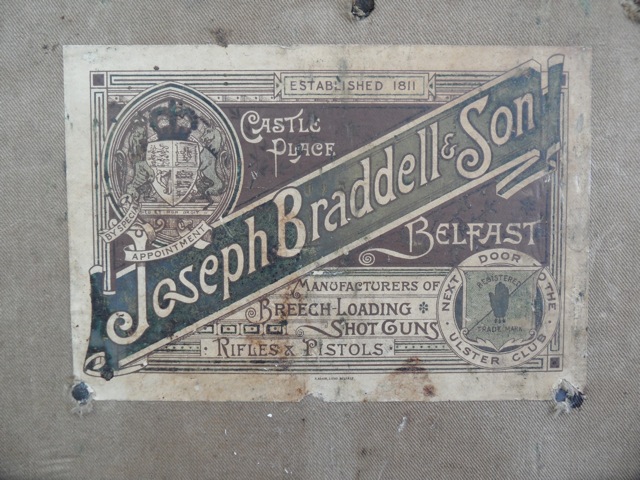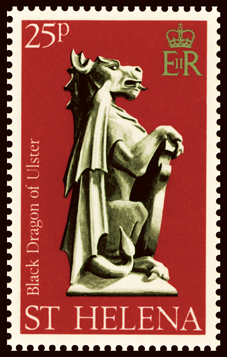On the run-in to what became the 1798 Rebellion, this account was published in The Northern Star in the 3-7 April 1797 edition:
'... in searching for arms in the Ards, on Friday, March 10, the soldiers sliced down a whole cheese and carried it off together with several articles both of provisions and apperall, at Mr Brown's (Portavogie). In the townland of Ballyhalbert, they tossed about three stacks of grain, belonging to Wm M'Whorter, and committed several other outrages. Almost every night since, an Ensign G- and Mr. P. G., seemingly intoxicated, accompanied by a few armed ruffians (not the military) paraded the town and country, to the terror of peaceable well-disposed people.
Widows, orphans, poor lonely women, and all others in unprotected circumstances, are the chief objects of their military vigilance and prowess. When their private orgies prevent their personal exertions, their emissaries rally forth in arms; scour the country at all hours of the night, force poor people from their beds, demand spirits or whatever else they choose, which, having devoured, they make off. If complaint is uttered they present cards or notes which they say contain orders from the aforesaid gentlemen for their proceedings.
On such occasions Master John H-, son to a gauger, is Captain Commandant, and Master John B-, son to the church clerk, Adjutant. It is expected that a sense of the meritorious exploits of the latter will recommend his father and family to the notice of the parish of Portaferry at next vestry. The Commissioners of Revenue will certainly promote the former. Any of the others whether higher or lower may be presented with more prominent features to the public, if their further merits call for notice. Let them be thankful at present ...'
Monday, December 30, 2013
Ballyhalbert and Portavogie, April 1797
Monday, December 02, 2013
An 1850s Massachussetts clock, via the Isle of Man, to the Ards
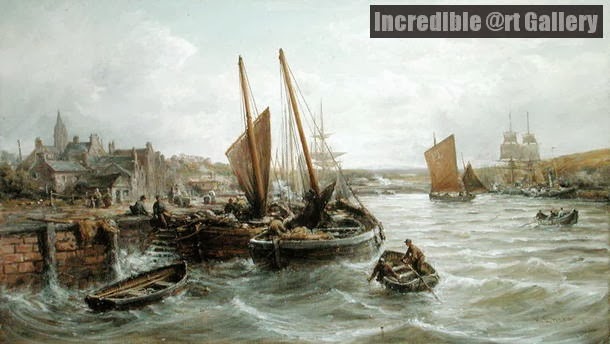
Above: Peel Harbour, 1893 // An old clock which was owned by my grandparents, and previous generations, has surfaced. The sellers label is from Joseph Clucas, Clock & Watch Maker, Peel (in the Isle of Man). Some Googling shows that his shop existed from 1850-1860, in Crown Street just off the main seafront beside Peel Castle and St Patrick's Isle. Peel is on the west coast of the Isle of Man, with many connections to east County Down over the centuries. Nearby Clucas' shop was a building called Thompson's House (see here).
According to a huge label inside, it was made by Jerome & Co, New Haven. Massachussetts. Again some Googling shows that the company went bankrupt in 1856, from a peak production level of 440,000 clocks per year. Their clocks are easily available on etc.
So, the story probably is that, in the early 1850s, some fisherman from the Ards was over in Peel and came home with a posh imported American gift for the wife. Pics to follow.
Thursday, November 28, 2013
When the Orange Lodge protected the local Priest (part 2)
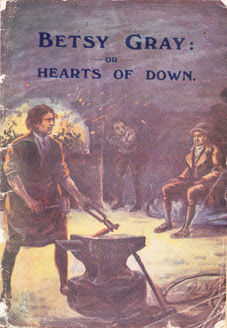
Here is the full story as told in Betsy Gray and the Hearts of Down (first published in 1896):
'... THE TOWN of Lisburn not only supplied the noble and generous hearted General who commanded the troops of the United Irishmen, but it also played an important part in the short but sanguinary struggle. During the winter of 1797, a shuttle-maker who lived in an entry off High Street, Belfast, worked eighteen hours of the twenty-four in making pike-heads and handles. He and very many similar experts were, however, outdone by a Lisburn white smith, who, during the winter of 1797 and spring of 1798, forged upwards of 500 pikes without leaving undone any of his ordinary work.
Many years before the rebellion of 1798 the Presbyterians of Lisburn had proposed to build a new house of worship. Lord Hertford gave them a handsome site, and subscriptions were collected towards defraying the cost of erection. Amongst the contributors were the Rev. Father Magee - the parish priest - and several members of his congregation. Father Magee gave £10, and the donation was very much prized by the Presbyterians. He was exceedingly popular, and, when any works of benevolence were to be performed, he was always beside the Rev. Dr. Cupples, Protestant rector of the parish, and the Rev. Andrew Craig, Presbyterian minister.*
There was wonderful excitement in Lisburn and its neighbourhood on the night of the 12th of June, 1798. A report had been circulated that. Harry Monro and a large body of his men would that night descend upon the town and destroy it by fire. Soldiers, horse and foot, paraded the streets in large numbers; the inhabitants were ordered to close their doors and put out their lights after eight o'clock, and every measure was taken to prevent a military surprise.
In a house in Market Square sat an Orange Lodge. At a late hour one of the members of this Lodge looked out of the door and saw the parish priest making his way homewards. The Orangeman was a member of the Rev. Craig's Church, and he had a kindly feeling towards Father Magee, because he remembered his kindness. Stepping up to the clergyman, he said -
"You are out very late, sir, in such troublous times."
"I am, indeed, my friend," replied the old gentleman. "I have been out on a sick call."
"It is a mile to your house, and you can hardly get there in safety," said the Orangeman; "our lodge is now sitting, come in for a moment and we'll see about guarding you home."
The priest entered the lodgeroom, where he was hospitably received, and, having remained there for some time, he was escorted home by four of the members...'
*Rev Andrew Craig is another man with a fascinating story. That's a story for another day.
...................................................................................
Here is a fuller account by Hugh McCall, again from this website:
'... Priest Magee.
Reference has been made to the kindly spirit that had prevailed in early times between the people of this town and the clergy of all sects. The Rev. John Magee, who had been curate of the chapel from 1762, and parish priest from 1770, was very popular. When the Presbyterian meeting-house in Market Square was in course of erection, he handed ten pounds to the building fund committee as his own and that of a few of his people's contribution towards the good work. Like the Rev. Edward Kelly, P.P., who has held that position in Lisburn more than one quarter of a century, and while zealously attending the duties connected with the creed of his fathers, never interfered with the private opinions of those of other denominations. Priest Magee delighted in cultivating social harmony with all around him, and by his own followers he was held in special veneration. He took much interest in the Volunteer movement, and, when leisure permitted, was among the spectators who usually assembled in large numbers to witness the parades of the local troops, as the men met for military exercise on Gough's Hill, now a portion of the Wallace Park. And at the tables of Poyntz Stewart, Commander of the True Blues; Thomas Ward, Captain of the artillery; as well as those of other Volunteer officers, Priest Magee was ever a welcome guest. With the popular rector of Lisburn and the Presbyterian minister, he lived on terms of the utmost friendliness. Among the many unwritten histories of the Irish Insurrection, the following incident, as taken by the narrator from the lips of one of the Orangemen who took part in it, will be read with some interest.
The Priest and the Orangemen.
An Orange Lodge was sitting in the front room of a house in Cross Row. Two members of the lodge who had come downstairs to look on the stirring scenes on the street were at the door, and while standing there they recognised the parish priest passing along on the opposite side. Both these Orangemen were well-known to Mr. Magee, and immediately on seeing that gentleman they rushed across the roadway, and, after apologising for stopping him, they added that such was the state of the town, and the excitement of party spirit, it would be very dangerous for him to attempt making his way home, "Gentleman," said the venerable clergyman, "I have been out attending a sick call; one of my people, who lives at Plantation, became suddenly ill, and I have got so far on my return. It is exceedingly kind of you to give me the information about the unsettled state of affairs, but I hope to get on my way without molestation."
"We cannot permit you to go alone," replied the younger of the two; "our lodge is sitting in Jemmy Corkin's, the business of the evening has been settled, and if you come over with us we will arrange for your safe convoy home." It was then nearly seven o'clock: all was excitement in the Square, dragoons were dashing furiously round the Market House, and heavy artillery guns had been placed across the head of Bridge Street. After a few moments' hesitation, the priest said he would place himself in the hands of his friends, and on entering the lodge-room the Rev. gentleman was courteously received by the master and members. Having partaken of some refreshments, half-a-dozen stalwart men, well armed, rose and proceeded to escort Mr. Magee to his cottage home, which was situated about a mile distant on the Moira Road. It was nearly midnight when the party arrived at the priest's dwelling. A suitable entertainment followed, during which the hospitable host once again gratefully acknowledged the special attention that had been paid him; and, to the latest period of long life, the old clergyman was wont to relate the romantic story of his having been escorted to his home at Lissue by six Orangemen the night before the Battle of Ballynahinch ...'
...................................................................................
Postscript: In O'Laverty's An Historical Account of the Diocese of Down and Connor, he says that Father Magee was from Corbally in Ballee parish near Downpatrick. During his time as a priest in Lisburn he lived on the Maze Road, and was responsible for building a Catholic church at Chapel Hill in Lisburn in 1786 which was then enlarged in 1841. The tower of the building is recorded as having a plaque which read 'This chapel was built by donations from the people of every religion in the county, to preserve in grateful remembrance such Christian concord this stone is erected'. This was assisted by Dean Stannus, on behalf of the Marquis of Hertford, who gave land and money to the project. In 1792 Magee officiated at a Mass in Lisburn chapel which was attended by 'The Volunteers accompanied by many Protestants'. The Northern Star of 16 May 1797 printed this story: '...Daniel Gillan, Owen McKenna, William McKenna, and Peter McKenna, privates in the Monaghan Militia, who had been tried by a Court Martial in Belfast, were conveyed to Blaris Camp on cars, accompanied by two priests (Rev. John Magee and Rev. Peter Cassidy, C.C.Belfast) and by a strong guard of horse and foot, and shot at two o'clock. They seemed very sensible of the awful change they were about to make ; and at the same time behaved with the greatest firmness, choosing rather to die than turn informers ...' More of this story can be read here - beginning on page 11 with an account of the Portaferry-born informer, Bell Martin.
Hugh McCall of Lisburn (1805-1897); when the Orange Lodge protected the local Priest.

Hugh McCall is one of the many forgotten men of Ulster history. In his day he was a renowned writer, collector of folk stories, founder of a literary society, chronicler of the linen industry, occasional editor of The Banner of Ulster and expert on the 1798 Rebellion. He also took a prominent part in the Burns Centenary commemorations in Belfast in 1859. There is a memorial plaque inside Lisburn Cathedral to him, which reads:
Hugh McCall
1805 – 1897
One who was given to Philanthropy
Justice and Truth
A Journalist without fear
An Accurate historian
A Painstaking Chronicler
This Tablet
Is placed where he worshipped
To his remembrance by his friends
This above all to thine own self be true
And it must follow as the night the day
Thou canst not then be false to any man
I came across his work a few years ago. His grandfather left Argyll for Ulster, around 1714, and came to Donaghadee but then headed into the Lagan Valley area. Hugh was born at Chapel Hill in Lisburn. Joseph Carson of Kilpike regarded McCall as a 'brother poet', and wrote this verse to him:
To Mr. Hugh M'Call, a Brother Poet.
Lord, man, I think it dev'lish queer,
We've bardies been this many a year,
Baith bustling on in life's career,
Unknown to ither,
An' neither wrote ae line to cheer
His rhymin brither.
Had I but known, my cantie blade,
Ye plied sae weel the "rhymin trade,"
I would hae some bit sang convey'd
To thee lang syne,
Ere friendship's lamp was quite decay'd --
Dear light divine!
The dearest blessings o' mankind,
Are no' to rank an, wealth confin'd --
The cottage wight an' labouring hind,
Fu' aft enjoy them,
While lords to mak an riches join'd.
As aft destroy them.
When life's lang toilsome day is o'er,
The question, were ye rich or poor?
Will no be asked, on death's far shore,
To us poor mortals,
Ere mercy opes the narrow door, --
Heaven's shining portals. Here is a great 1798 rebellion story which McCall collected, reproduced here from this website:
'... In these perilous times Mr. McGhee, the Parish Priest, was going out one night to visit a parishioner in Blaris. An Orangeman, who knew the popular priest told him of his great danger owing to the mob on the road, invited him into the house where an Orange Lodge was sitting, where he remained in safety, and was afterwards accompanied by a guard of Orangemen ...'
In Betsy Gray and the Hearts of Down, WG Lyttle recounts that Father Magee and some of his congregation had helped to fundraise for the building of Lisburn Presbyterian Church, giving £10, - '... and the donation was very much prized by the Presbyterians...'.
The loss of stories like these impoverishes the Northern Ireland of today. Men like McCall deserve to be more widely known.
Saturday, November 23, 2013
Friday, November 22, 2013
Two Holestones - Ulster and Scotland
As far as I am aware, there is only one 'holestone' left in Ireland. It is near Kilbride Presbyterian Church, on the slopes of the Sixmilewater Valley of southern County Antrim (click here).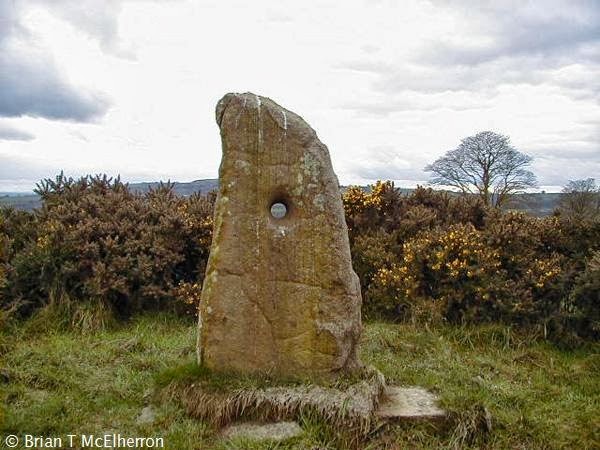
There is I understand just one more in the British Isles, called the Crouse Marriage Stone or Crow Stone, near Wigtown in Galloway, Scotland (click here). 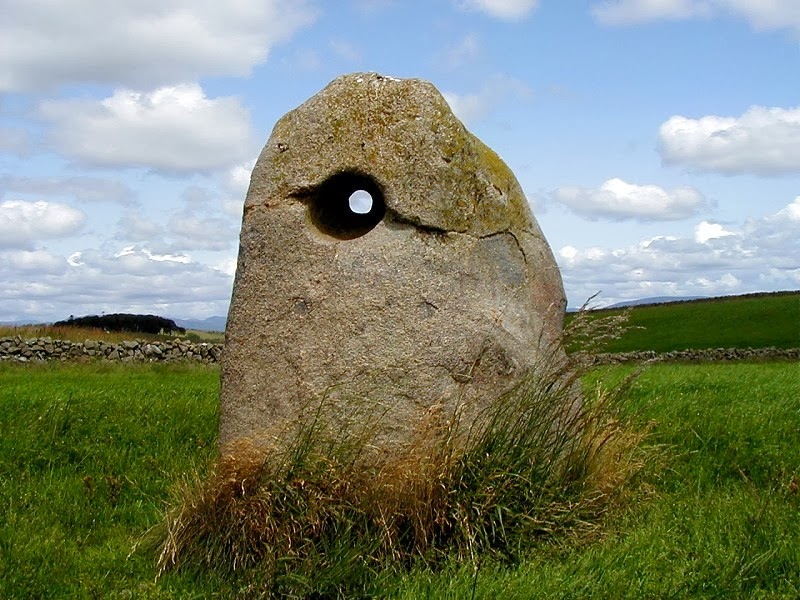
If anyone can tell me of others, I would appreciate it.
Mandolin tuning - "It's never perfect, but we do the best we can"
When in tune, the sound is wonderful. When even slightly out of tune, it is woeful. As the man below says, "if you've been playing mandolin for 30 years, you spend 15 of those years mandolin tuning and the other 15 years playing out of tune".
Wednesday, November 20, 2013
Official Tourist Guide to County Down and the Mourne Mountains, 1924
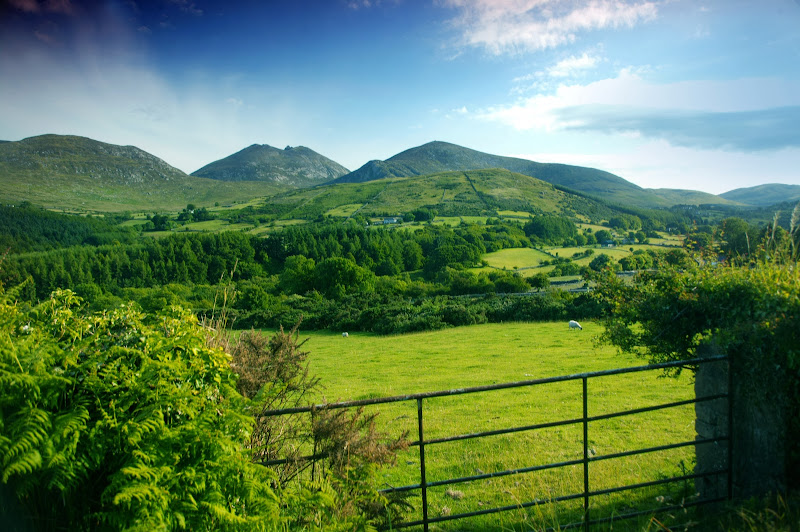
Image above - ©NITB
I picked up a great 89-year-old book for a few pounds recently. It begins with this -
"The delightful air and scenery of the County of Down, and the retention within its boundaries of so many remains from Pre-Christian, Early Christian, and Norman times, and by its people of so many characteristics of speech and manners from Plantation days, make this territory, for the tourist, one of the most interesting in Northern Ireland..."
and goes on:
"... One thing which will be apparent to even an unobservant tourist is the Scottish character of the people over large area; indeed until recent times, when school attendance was enforced, the language of the people in large parts of the north and east was purely lowland Scotch. The reason for this is that among the early acts of James I were the grants of large areas of land to his Scottish favourites, James Hamilton and Hugh Montgomery. Both these adventurous spirits were first knighted, and later both attained the rank of Viscount. Hamilton made his headquarters at Bangor, then a little village on the southern shore of Belfast Lough. Montgomery settled a few miles further south at Newtownards. Both men were followed by a number of their relations from Scotland, and both brought over large numbers of settlers; and all the Ards area, or say the upper half of the county to the eastward, may be said now to be peopled by the descendants of those settlers, who, as stated above, spoke, until very recently, the Scottish tongue of their forefathers ..."
It is always remarkable how mainstream and understood our connections with Scotland were to previous generations. Today you'd be hard pressed to find a history teacher in a secondary or grammar school in the area who could give such a succinct and accurate account. And we wonder why Irish history is sometimes a 'battlefield' - it must be because so few really know it today. It is selectively deployed for devious reasons.
"... GOLFING - County Down is one of the most important centres of the ancient and royal game of golf outside Scotland..."
The descriptions of the towns and villages are packed with references to Hamilton and Montgomery, and an account of the Con O'Neill escape from Carrickfergus is included too - sitting comfortably within information about local landmarks, hotels, and recreation facilities, painting an overall picture of the places. It mentions the Bible texts which Montgomery had carved into the entrance of Newtownards Priory (the originals are long eroded, and the 1988 reproduction did not include the original texts, probably an editorial decision by some anonymous bureaucrat). The insert map as well as the text refer to St Patrick's Well at Templepatrick, south of Donaghadee, where "we get pretty views of the coast and of the Copeland Islands with the Scotch hills beyond".
Bear in mind that this isn't a 400 year old document - this was published just about a decade before my parents were born - and yet popular awareness of the knowledge it contains has been almost completely lost over the past two generations!
As high-level political discussions continue here in Northern Ireland which seek an agreement on 'the past' - the question arises, "What version of the past?". The one which is reduced to nothing but a "them against us" two-tribes political stereotype - or the fuller, more accurate, cultural past from which this generation and the next generation can learn so much?
Tuesday, November 05, 2013
From Portaferry to Belfast to Australia
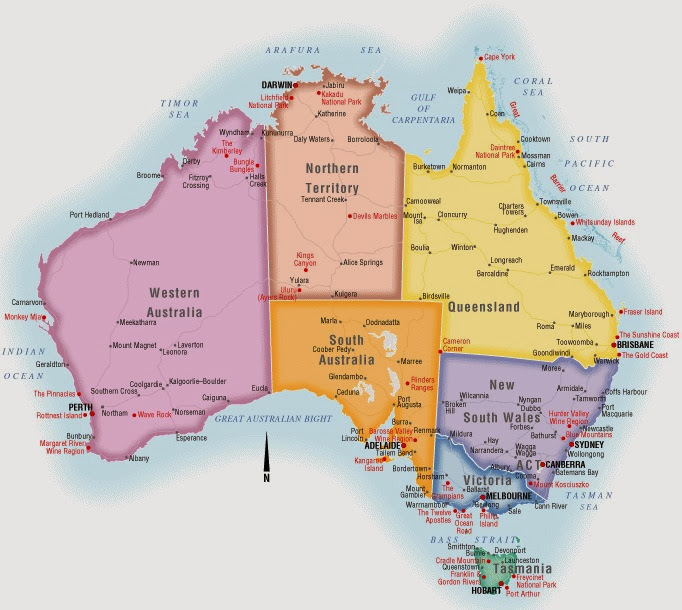
One of the joys of blogging is the contact it has allowed me to have with many people around the world. I have recently been corresponding with a man who now lives in Australia, but who was born and grew up near Portaferry. When he was a boy his family moved (back) to Belfast and much of our discussion has been about the culture shock that this caused him as a child. He has allowed me to post some excerpts here, which I will add little bits of commentary to.
'...I find myself describing the cultural and geographical background of my early childhood in similar happily reminiscent terms as your article; having been born and in early childhood bred environmentally on the Ards Peninsula nearby Portaferry...'
He shares my frustrations at the present-day media insistence of Ulster-Scots as a recent 'invention':
'... I never had personally any impression that "Ulster" and "Scots" effects have only recently been imported from Scotland... I was born on the Ards Peninsula because my mother basically fled Belfast due to the forthcoming Blitz in the war (WW2). But back in Belfast (outer west Belfast) in 1948, my father worked the barges etc., for the Belfast Harbour Commissioners on Victoria Channel and Belfast Lough and quite a familiar familial topic my father regularly commented to us about was the "Portavogie Scots" (he called them) coming up and in effect taking jobs from Belfast's own "local" harbour workers...'
His father was a man more concerned with an invasion of Portavogie men, than he was of the Russians:
'... My parents were oul ones and my father's way of the oul ones was hilarious. We never had news in our house. Everybody round our direction in the 1950s had Moscow as the place of much invisible threat to our future security. But for us with my father it was grim talk at the dinner table about the perils of Portavogie ...'
And he was a man with a long memory:
'... One interesting rival for the much feared Portavogie in our house in the 1950s was always announced by my father in the exact same omen-fraught words. "The Norwegians are in the night". Even the Dutch were a breeze in comparison to the primeval Norwegians as far as my father was concerned. The amazing thing was it didn't matter what part of Belfast you were from out on the Lough, they all never forgot how the Norwegians came and burnt down Holywood and all along the shore towards Bangor and Donaghadee. I think it was 800 AD or round about then. Apparently my father and the other bargehands never got over that. So I always kept out of the road of the Norwegians myself when I got up...'
He described himself to me as 'ethincally Celtic Irish in today's popular observations', but with 'a British birth certificate' who enjoyed childhood on the 'Norman-French estates' of the Ards Peninsula.
'... When I (with my parents) moved to Outer West Belfast in 1948, I felt always an immigrant from the Ards Peninsula and the view of the Mountains of Mourne overlooking the Ards Peninsula encouraged memories of the above background, environment and geographies of the Ards when I was a child ...'
So, a complex, interesting, humourous, down-to-earth series of memories and observations. I'd love to meet him some day, he sounds like a man with oceans of stories to tell.
Tuesday, October 29, 2013
Wee Sunday School songs
These come back to me every now and again, learned at Carrowdore Sunday School over 30 years ago.
Look them out, get them gone
All the little rabbits in the fields of corn
Envy, jealousy, malice and pride
These must never in my heart abide
It's a moral lesson from Mark ch 7 rather than clear gospel theology - but there are some folk who could do with looking in the mirror and learning from its wisdom.
Saturday, October 26, 2013
A forgotten Ulster author - Richard Cuninghame Esq. of Castle Cooley, Donegal (c. 1832 – 1908)
Over the centuries, some writers have published popular novels to bring Ulster-Scots history to the general reader. Richard Cuninghame is one I have recently discovered.
In Bonds but Fetterless (1875)
This two volume novel is set in 1660s County Down during the time of Captain Thomas Blood's plot to storm Dublin Castle and kidnap the Lord Lieutenant of Ireland. Many Ulster Presbyterian Covenanters were involved in this attempt, and more were seized and arrested on suspicion of involvement. A description of the novel reads as follows:
'... Historical fiction set in Ulster in the time of Charles II. The novel's introduction mentions details of the plantation of the Scots in Ulster under King James I. The story opens in 1661 in a farmhouse of Scottish Presbyterians in Co. Down and deals mainly with relations between the Afton family of Ellerslie and survivors of the O'Neills, who still inhabit their ancient castle, some of whom have become Protestants. The book presents the reactions of the Ulster Presbyterians to the persecution started by the 'Prelatic Church' under Charles II. A conspiracy by the Covenant is begun by two dubious characters, Blood and Lecky, but Ulster Presbyterians hold aloof. Many personages of the day are introduced and the plot moves between Belfast ('Plekopolis') and Dublin...'
A quick Google search shows it among the collection of Brisbane Circulating Library, Australia, being advertised in the Brisbane Courier on Monday 3 December 1877.
The Broken Sword of Ulster (1904)
This is a popular account of events in Ulster from the late 1500s through the Nine Years War, the death of Elizabeth I, the escape of Con O'Neill, O'Doherty's rebellion and the Plantation. The scattered footnotes show that Cuninghame's story drew heavily from the accounts of Andrew Stewart, Rev George Hill and Rev James Seaton Reid. The book is now available online here. It was probably published after Cuninghame had died.
Biography
Richard Cuninghame is believed to have been born around 1832, the son of Dr Hugh Cuninghame (1794-1878) of Castlecooley, near Burt, in Donegal (Dr Cuninghame is said to have been at St. Helena while Napoloen was exiled there from 1815–1821).
On 29 November 1860 Richard married Mary Henry from Tassagh, Armagh, at Tassagh Presbyterian Church - and in the 1869 Hill edition of the Montgomery Manuscripts, 'Richard Cunningham, esq., Castle Cooley, County Donegal' is listed in the Preface as one of those who assisted with the footnotes research. The National Library of Ireland has his genealogical research (see here) compiled in 1898. A collection of his papers and manuscripts may still exist.
He died on 2nd May 1908 at his home at 3 Salisbury Terrace, Portrush, in his 77th year.
His son was Rev Hugh Harvey Cuninghame who graduated from Trinity College Dublin in 1890 and became a Church of Ireland rector at Ballywillan, Magherafelt and Arboe.
Scottish origins
The History of the counties of Ayr and Wigtown (1866) contains these details about the family:
'... Not a few Ayrshire families are represented by branches in Ireland. This originated chiefly in the colonisation of Ulster by the Scots, under Montgomerie, in the hitter end of the reign of James I., and by subsequent emigration. Amongst other still existing Scoto-Irish families are the Cuninghames of Castle Cooley, near Londonderry. The first of them was the Rev. Hugh Cuninghame, who went to Ireland in 1642, as chaplain to a regiment commanded by the Earl of Glencairn. About that period, an army of ten thousand men, chiefly from the west coast, were sent over by the Scots Government to protect the colonists there during the rebellion. The Rev Hugh Cuninghame did not return with his regiment when the army was withdrawn, but settled as minister of the Presbyterian congregation at Ray, county Donegal, about 1G46. He was ejected by the Bishop of Raphoe in 1662. From this reverend gentleman the Castle Cooley family are descended ; but to which of the Scottish houses he belonged it is difficult, or perhaps impossible, to discover. He would be appointed chaplain by the Presbytery of Irvine : but, unfortunately, their records go no farther back than 1646, and not one of the parish registers exists at so early a period. The register of the University of Glasgow shows that a Hugh Cuninghame matriculated 1st March 1630, and graduated in 1634. This is no doubt the same party, but he is not designed. He was probably connected with the Cuninghames of Glengarnock, who sold that property, and went to Ireland about 1600. Their place, Castle Cuninghame, is near to Ray (Donegal) ...'
Friday, October 18, 2013
Thursday, October 17, 2013
When Northern Ireland spoke for Britain - a 1956 advertisement for the British Travel Association

This ad is from the US magazine 'Holiday', for the British Travel Association. The main image is of Greencastle, County Down, on the shore of Carlingford Lough. It's an area with both Viking and Anglo-Norman heritage. It was captured by Edward Bruce in 1316, and is also recorded that his brother King Robert the Bruce of Scotland offered to broker a peace agreement with the King of England - with Greencastle as the proposed venue for the negotiations - around 1326. Edward Bruce was of course killed nearby in a battle in 1318 and his body (or bits of it at least) are buried in an ancient graveyard there.
Greencastle was used as an English garrison in the late Elizabethan period in the 1590s - and it's still an impressive building and location today. Northern Ireland is seldom, if ever, used to promote the wider 'nation' (however you choose to define that), we tend to get pushed to the periphery. How different it was 50 odd years ago. I still believe that our multi-cultural mix makes Northern Ireland one of the most interesting heritage locations in the UK / Ireland. My English relatives were surprised to see so many Anglo-Norman castles in our small area of east Down on a visit last year.
I was fishing for tope on Carlingford just over a year ago with some friends and took the photos below from the boat.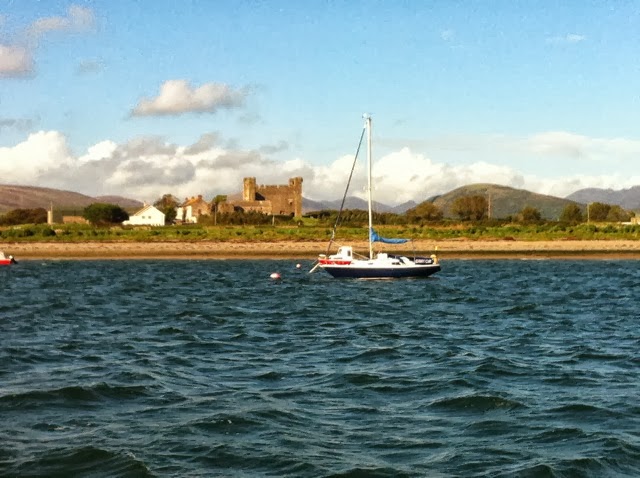
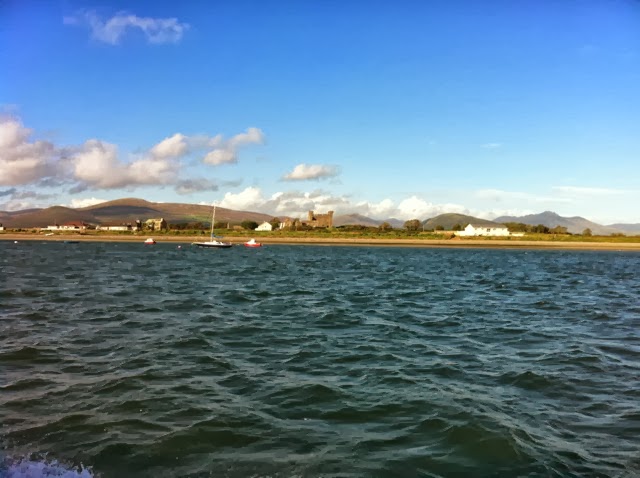
Below: The view from the Irish Sea into the mouth of Carlingford Lough - Co Louth to the left and Co Down to the right.There is some talk about building a bridge across the Lough.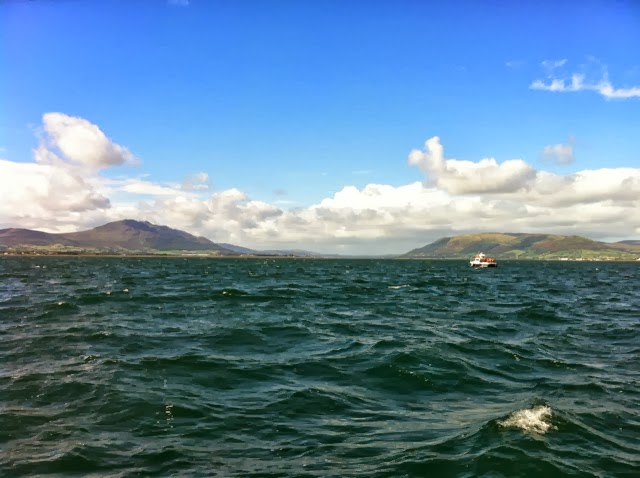
Monday, October 14, 2013
Robert Burns Centenary Celebrations - the Music Hall and the Corn Exchange, Belfast - 25 January 1859
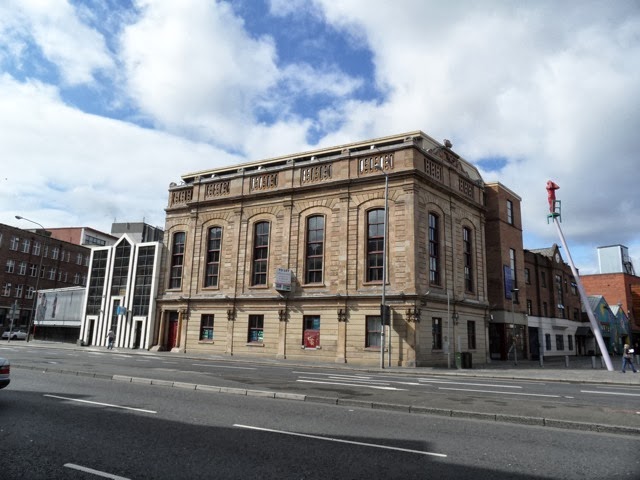
At Belfast Music Hall a festival was held (and in other towns in Ireland too). Professor George Lillie Craik (who just 2 years later published 'History of English Literature and the English Language') of Queens College gave a rousing speech which included these remarks:
'... this is not Edinburgh or Glasgow, but Belfast. It is true that Burns belongs to Scotland, and not to Ireland; but besides that, many of us now present are Scotchmen by birth, and can only claim the honour of being Irish by adoption, or by sufferance; it might also be made a matter of question whether this Ulster of ours be not really more a part of Scotland than a part of Ireland ... we have come over and set up another Scotland here - an Irish or Little Scotland, as it may be called. We have made this Province of Ulster - this Black North - half Scotch, or more than half Scotch, in almost everything – in blood, in language, in religion, even in mind and character ...'
Hugh McCall of Lisburn said that '... not even in his own Ayrshire is the poetry of Burns held in higher estimation than it is in the counties of Down and Antrim ... Had the poet Burns, when on his deathbed in Dumfries, been able to look through the vista of years, and see that, at the end of a century from the date of his birth, the people of Belfast would have met in such glorious assembly as I see in this room, it would have given comfort and no doubt considerable happiness ...'
Burns' daughter and granddaughter were among the crowd that night. At the same time as the Music Hall banquet, a soiree was held at the Corn Exchange (pictured above) with about 400 in attendance 'composed principally of the more respectable of the working orders', with prominent figures such as Rev Dr M'Cosh, Rev Hugh Hanna, Rev George Cron, Rev Mackey and Mr John Ritchie all in attendance. The Oldpark Band were there and played a selection of Burns' airs throughout the night, and Ritchie sang a rendition of 'Rantin Rovin Robin'.
Detailed accounts of the events in both places are readily available.
Friday, October 11, 2013
Belfast-Glasgow Wine Jug
One from the collection which came up in conversation the other day, probably made for a firm called John Grant Wines & Foods Ltd who owned various hotels and restaurants on both sides of the water. The curved message reads 'A meal without wine is like a day without sunshine'; the four venues are the Grand Central in Belfast, Rogano Restaurant & Sea Food Bar in Glasgow, the Royal Restaurant in Glasgow and the Buchanan Arms Hotel in Drymen, north of Glasgow. Made by J Abrahams & Sons Ltd, no date marked on it but must be around 1927 when Grant took over the Grand Central. It was demolished in the 1990s and CastleCourt shopping mall is on the original site. See article here on CultureNorthernIreland.org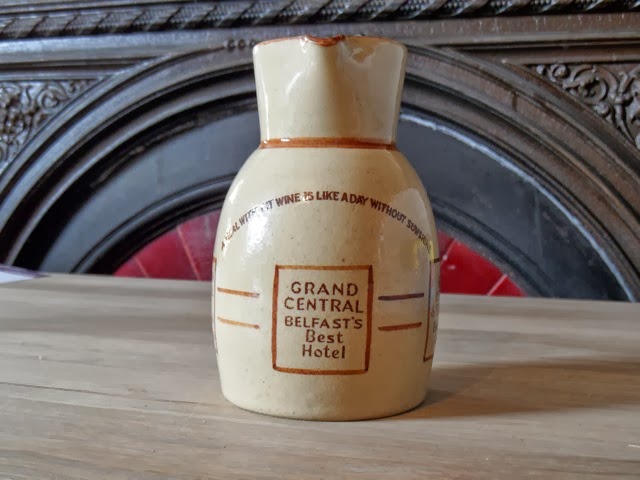
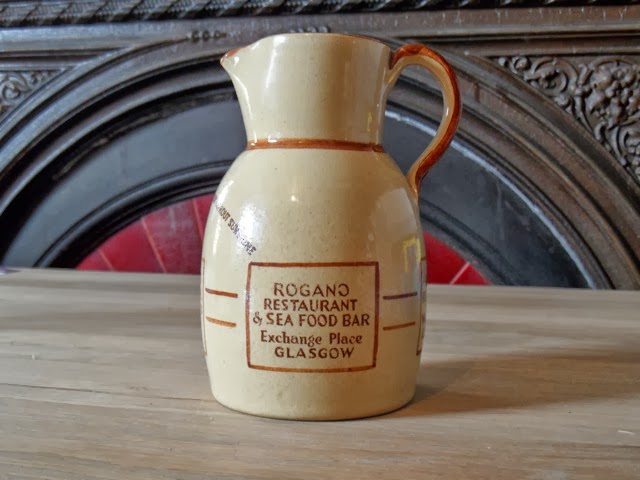
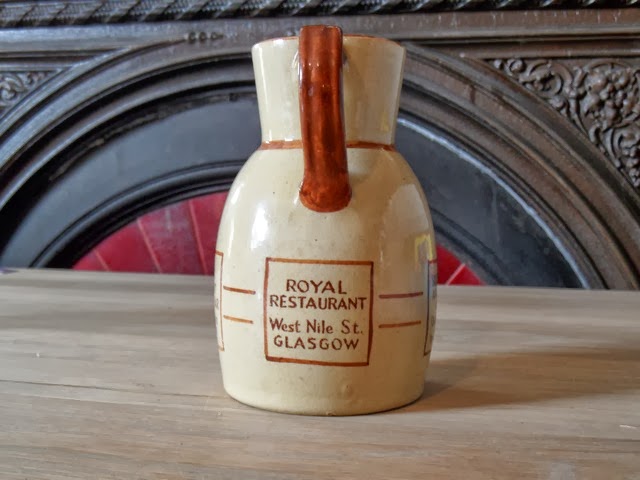
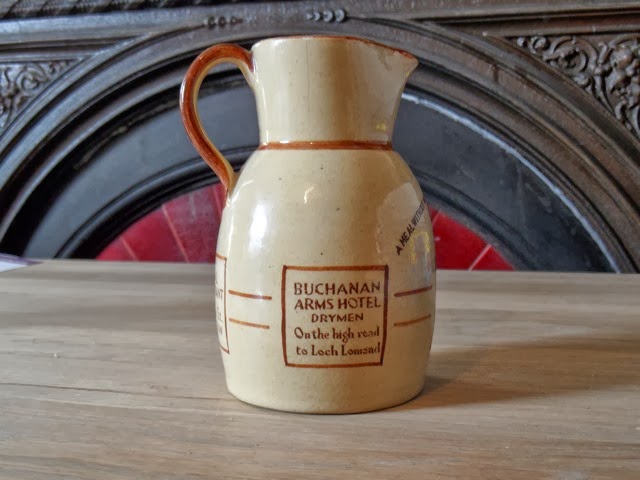
There is a similar example online here.
Thursday, October 10, 2013
George Francis Savage Armstrong (1845–1906)
Some of you will know how much I enjoy this man's work (see this previous post) both his poetry, some of which is Ulster-Scots, and also his epic family histories. I was pleased to help Rosemary Raughter from County Wicklow earlier this year who has published this online article about his time in Wicklow. Over the summer I went looking for his grave up at Ardkeen Church - it is thought to be among the thick overgrowth below the ivy on the wall of the building. It has been described as a 'monumental altar-shaped tomb outside, and close to, the south wall of the ruined Church'.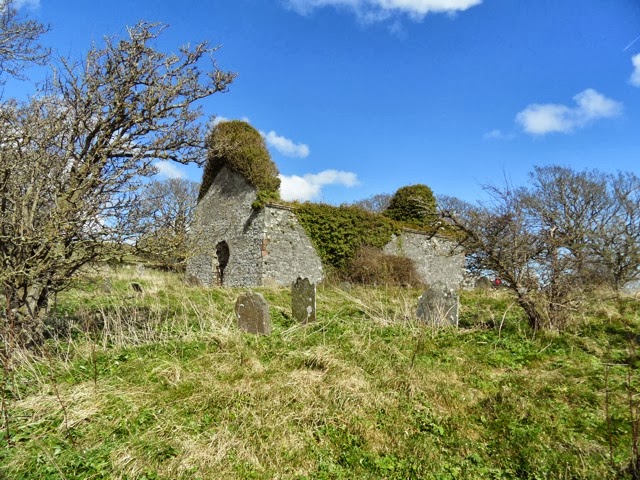
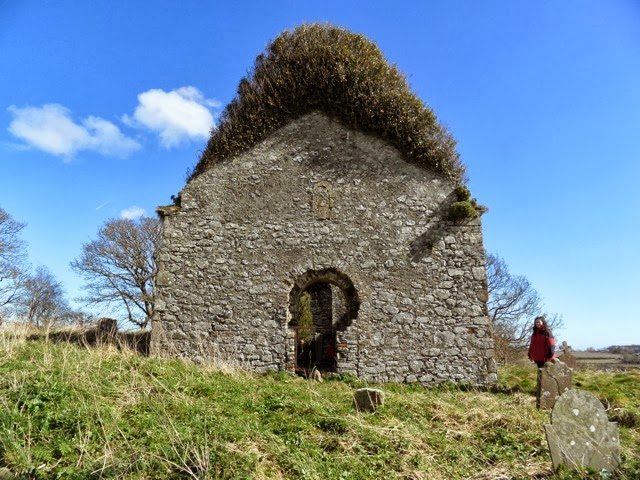

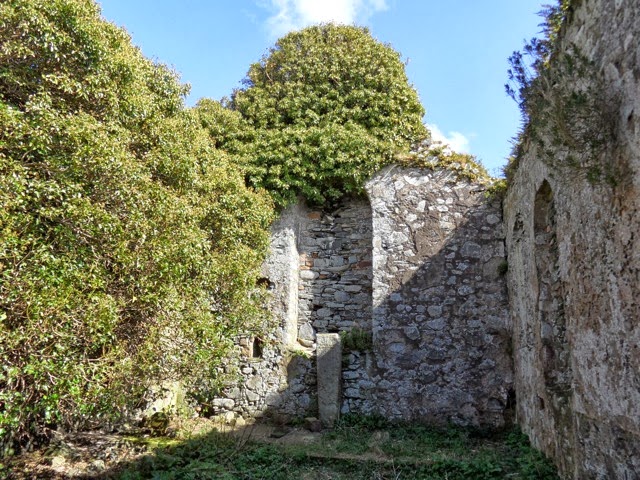
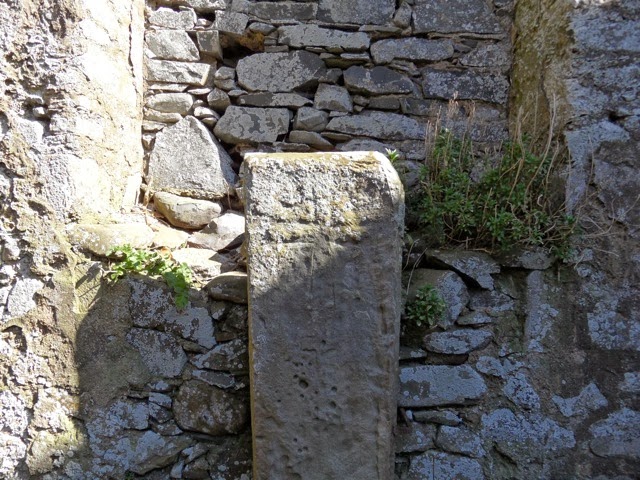
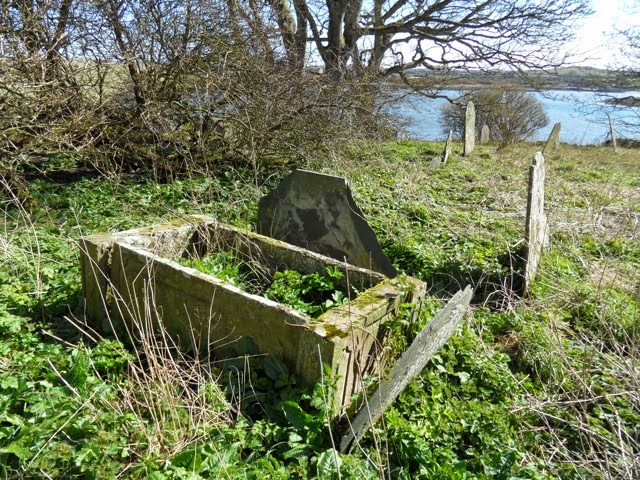

He lived in his latter years at Strangford, in the house which overlooks the village, shown here just behind the old castle. A selection of his work, Poems National and International, was published in 1917 as a memorial to his eldest son, the Dublin-born Lieutenant-Colonel Francis Savage Nesbitt Savage-Armstrong, who was killed at Arras on 23rd April 1917 whilst serving with the Royal Warwickshire Regiment, aged 36.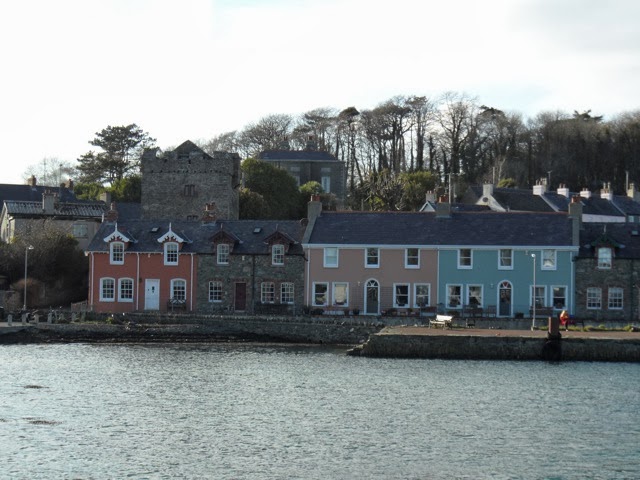
Monday, October 07, 2013
Saturday, October 05, 2013
An Ulster-Scottish-Viking-Pictish artefact
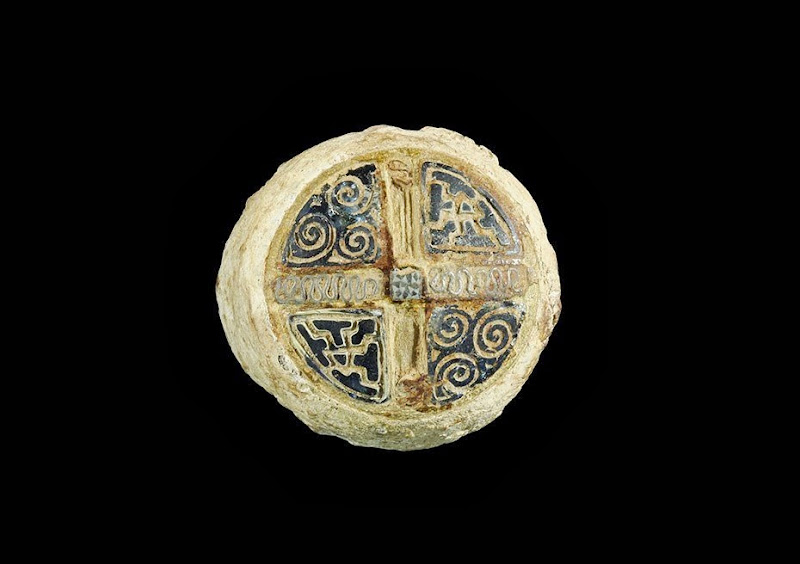
Coming up for auction in England soon is this artefact. It had the following remarkable - truly multicultural - description:
8th-10th century AD. A Hiberno-Norse discoid weight with domed upper face with inset decorative panels comprising two quadrants with three spirals each, two quadrants with T-shaped keys executed in niello; between these interstitial bands of s-scrolled wire; central millefiori panel with chequerboard design; to the underside a discoid panel. 86 grams, 36 mm (1 1/2"). Found Northern Ireland, UK. The decoration of the quadrants is of Pictish workmanship. The same motifs are carved on the 8th century AD Hilton of Cadboll Stone (from Ross and Cromarty; now in the National Museum of Scotland) and elsewhere. These elements must be considered as loot or traded items which were embedded into a lead matrix in order to embellish the weight.
Auction listing is here.
(This artefact will get no media coverage as it's not political. And if a museum here purchases it, they will probably interpet it as merely geographically Irish thereby losing the nuanced and important cultural complexity)
Friday, October 04, 2013
Thursday, October 03, 2013
Sunday, September 29, 2013
George Wishart, the second Scottish martyr, 1546
Following on from the previous post about Patrick Hamilton, the second martyr in Scotland was George Wishart, who like Hamilton was burned at the stake in St Andrews. Earlier this year, the University of St Andrews hosted a conference to mark the 500th anniversary of Wishart's birth in 1513. Some details are online here and also here. Another link with recent blogs posts here is that Samuel Rutherford was buried at St Andrews. Here is a pic of his gravestone. There is an impressive martyrs monument in St Andrews.
Wednesday, September 25, 2013
Patrick Hamilton, the first Scottish martyr, 1528
I've been reading a bit about Patrick Hamilton again. He was a follower of Martin Luther and visited him in Germany. Hamilton's only known writings, later titled Patrick's Places - are online here. And here is a simple biography of the man from 1918. Luther once wrote that '... Virtually the whole of the scriptures and the understanding of the whole of theology–the entire Christian life, even–depends upon the true understanding of the law and the gospel...' . Patrick Hamilton wrote this:
A DISPUTATION BETWIXT THE LAW AND THE GOSPEL.
The Law saith,
Pay thy debt.
Thou art a sinner desperate.
And thou shalt die.
The Gospel saith,
Christ hath paid it.
Thy sins are forgiven thee.
Be of good comfort, thou shalt be saved.
The Law saith,
Make amends for thy sin.
The Father of Heaven is wrath with thee.
Where is thy righteousness, goodness, and satisfaction?
Thou art bound and obliged unto me, to the devil, and to hell.
The Gospel saith,
Christ hath made it for thee.
Christ hath pacified him with his blood.
Christ is thy righteousness, thy goodness, and satisfaction.
Christ hath delivered thee from them all.
Bad religion is a long list of rules for people try to keep. True religion is a long list of rules which demand perfection - and which you therefore know you can never keep - but which Someone else has kept on your behalf.
..................
King James V was king of Scotland when Patrick Hamilton was martyred on 29 February 1528 - Hamilton himself was of Royal descent through both of his parents. In fact, King James II of Scotland was a great-grandfather of both King James V and Patrick Hamilton too.
Over in Ayrshire, another branch of the family was led at this time by Archibald Hamilton of Raploch (1504-1559), who is described on a gravestone in Dunlop as being 'a servant of King James the Fift'. Photos below are from one of my visits to Dunlop.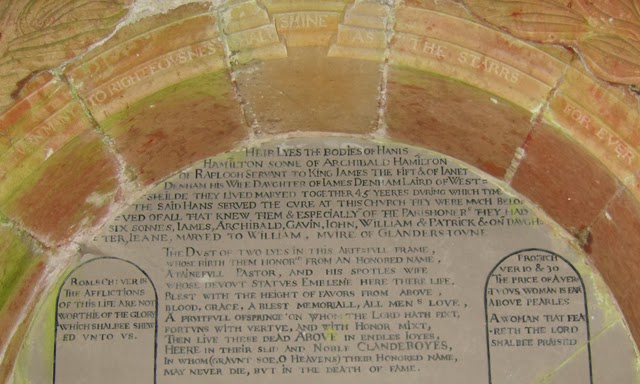

There is no doubt that Archibald Hamilton would have been aware of the burning of his relative Patrick. Archibald died on the cusp of the Scottish Reformation and his son Hans Hamilton became the first Protestant (Presbyterian) minister of Dunlop, Ayrshire - and Hans' son would later become Sir James Hamilton, one of the 'Founding Fathers' of the Ulster-Scots.
Thursday, September 19, 2013
The Shackleton Banjo - 'A British-made Banjo for the People ' - 'Vital Mental Medicine'
Check it out on Kickstarter here.
Monday, September 16, 2013
Buy Ailsa Craig - now for sale at £1.5m
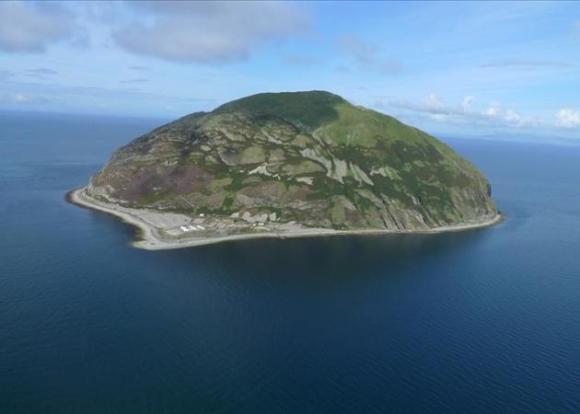
Even if you don't have the money (I'm going to have a rummage in the biscuit tin later just to see) the slideshow is worth looking at - click here.
Thursday, September 12, 2013
Samuel Rutherford's connection with the Ulster-Scots Montgomeries of County Down
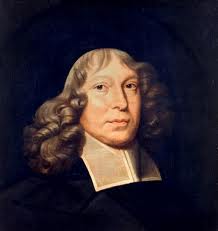
In Edinburgh on 24 March 1640 the famous Scottish Presbyterian minister Samuel Rutherford married Joan/Jean Montgomery. She was the daughter of an Edinburgh merchant and widow of a Hugh Montgomery who is described as 'sometime of Balharie in the country of Doune'. Joan's surname had been Mackmath/MacMath/McMath before she married Montgomery. I have discovered the connection in a legal document during Cromwell's occupation of Scotland, written in Edinburgh on 26 July 1653, seemingly granting a large amount of formerly Montgomery lands in Wigtownshire to John Shaw of Greenock. The Shaws and Montgomeries were also intermarried; the Shaws too had land in Ulster, initially near Ganaway between Millisle and Ballywalter, and later at Ballygally Castle.
As I've blogged here before, Rutherford was a close associate of many of the early Ulster Presbyterian ministers such as John Livingstone, Robert Blair, Robert Cunningham and John MacLellan. In 1640 he, Livingstone and Maclellan were reported to the church authorities for encouraging people to organise communal Bible studies and prayer meetings in their homes at evening time, outwith the formal church services. Anyway, here is the text of the document -
...................
REGISTER OF THE GREAT SEAL of SCOTLAND (RMS) Under the Commonwealth (Cromwell).
Vol. X, pages 81 & 82, #164....
July 26 1653. (short extract)
The Keepers grant to Johne SHAW of Grenocke / Greenock (m. to.................?)
the 10 pound land of PORTRIE, (Wigtownshire, Scotland) viz : -
MARROK (Marroch / Marrock) with the castle, tower and fortalice of DUNSKEY situate thereupon ;
corn-mill of PORTRIE, with the 3 mills and mill-lands, etc. viz :-
10 pound land of PORTRIE,
5 pound land of KINGHILT,
3 merk land of DUNTOUNE,
port called PORTPATRICK ;
lands of MAROK and DUNTOUNE,
with several crofts of the said port ;
3 merk land of ENOCH ;
2 merk land of MEKEL PIGMANOCH;
3 merk land of CRAIGOCH ;
town or burgh of MONGRUMIE (MONTGOMERIE)
sea port of old called PORT PATRICK and now PORT MONGRUMIE,
with the whole anchorages, tolls, customs, and other privileges, &c., pertaining thereto, -
with the castles, towers, fortalices, manor-places, &c., of the foresaid lands,
all lying within the sheriffdom of WIGTON (Wigtownshire, Scotland) ; -
which lands pertained to HEW (MONTGOMERY), now Viscount of Airds / Ards,
his father, and were apprised from him on 1st August 1650,
at the instance of JOANE MONTGRUMIE (Montgomerie) alias MACKMATH,
relict (widow) of the deceased HEW MONTGRUMIE (Montgomery) sometime of BALHARIE in the country of Doune,(co.Down, N. Ireland) gentleman, and of (Rev.) SAMUELL RUTHFUIRD , professor of divinity, University of Saint Andrews,
now spouse of JOANE (widow of) MONTGRUMIE (Montgomerie) alias (nee) MACKMATH,
for his interest, which decree of apprising was assigned by the said JOANE MACKMATH
with consent of the said SAMUELL RUTHFUIRD to
Andrew WARDLAW, merchant burgess of Edinburgh,
by assignation dated 15th June 1653,
and was assigned by the said Andrew WARDLAW
to the said Johne SHAW
by translation dated 22nd July 1653 :-
With precept of sasine.
P.R. vii. 82.
...................
It's hard to believe that such a legal document would make a mistake on the identities of the people involved.
• This shows that the Hugh Montgomery who had been Joan's husband, was one of the Montgomeries of the Ards. That's the only reason she would have been involved in the issue involving Dunskey Castle and the surrounding lands.
• Depending upon how you read it, perhaps she was a hitherto-unknown third wife of Sir Hugh Montgomery, the first Viscount of the Great Ards? He died in 1636, his second wife Sara (nee Maxwell) died on 29 March 1636, and he himself died in May of the same year. But did he marry Jean MacMath within these last few weeks of his life?!
• This was Rutherford's second marriage. He had been minister of Anwoth near Dumfries from 1627-1638.
• Dunskey Castle near Portpatrick, a castle which had been acquired by the Montgomeries in the 1620s (this document in Latin states 8 Feb 1620 as the date Hugh Montgomery bought 'Doneskey')
• So where is 'Balharie'? One online source suggests 'Ballehenrie' or Ballyhenry between Comber and Newtownards, however there is a Ballyharry townland outside Newtownards on the road to Donaghadee - both areas were 100% Montgomery land back in the early 1600s.
Some online descriptions of the Rutherford/Montgomery marriage:
'... In 1640, after ten years as a widower, Samuel Rutherford married Jean McMath, a woman who was evidently fitted for such a husband. She was described as "a woman of great worth and piety". One person who knew them both said, "I never knew any among men exceed him, nor any among women exceed her". Before he went south to the Westminster Assembly, three children were born to them, but two of them died in infancy...'
'... but this marriage also was filled with much grief. Although his wife outlived him, he lost his children through untimely deaths. The first two died while he was away in London attending the Westminster Assembly; only one of the five more children given him lived. God, however, uses even a man's sorrow for the comfort of others. To one who lost a son he wrote: "Your Lord may gather His roses and shake His apples at what season of the year He pleaseth." And to another he wrote: "I know there is a true sorrow that is without tears; and I know there is a real sorrow that is beyond tears."...
'... In the year 1640, he married his second wife, Jean M'Math, "a woman," says one, "of such worth, that I never knew any among men exceed him, nor any among women exceed her. He who heard either of them pray or speak, might have learnt to bemoan his own ignorance. Oh how many times I have been convinced, by observing them, of the evil of unseriousness unto God, and unsavouriness in discourse." They had seven children; but only one survived the father, a little daughter, Agnes, who does not seem to have been a comfort to her godly mother ...'
..............
• Jean MacMath outlived Rutherford - he died in 1661 and was buried at St Andrews; she is said to have died on 16 May 1675 and was buried at Greyfriars in Edinburgh.
• Here is a letter Rutherford wrote to Jean's sister Agnes upon the death of one of her children (click here)
• Information about other 17th century McMaths in Edinburgh is available here, from The Abbotsford Club
Tuesday, September 10, 2013
Churches
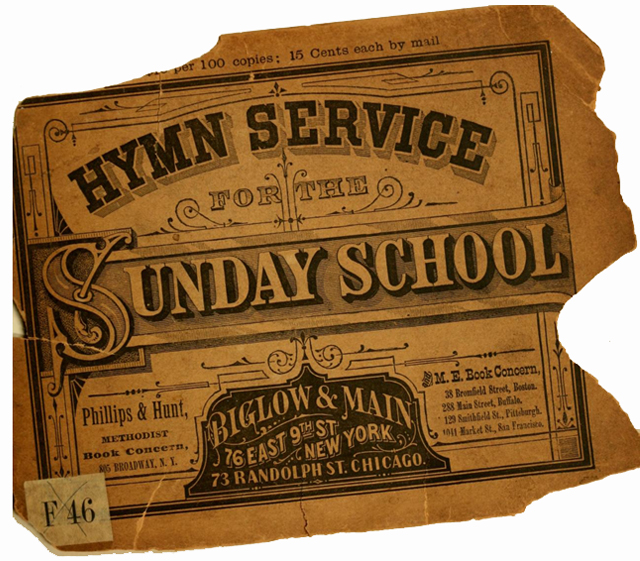
In Northern Ireland recently there has been some high profile media coverage of disagreements in a church which are reported to partly be about musical forms. Whatever the specific issues, there can be little doubt that in some quarters there is a general decline in Bible knowledge and literacy, and I would suggest especially within the younger generation. Songbooks for Sunday school classes of 100 or so years ago (such as this one, edited by Robert Lowry and published in 1881) when looked at today, appear to be far more advanced and demanding than today's equivalents. There does appear to be a 'dumbing down' trend.
Here is a hymn by John Newton, the author of Amazing Grace, from the late 1700s. I suspect thatconceptually, never mind the particular vocabulary in places, it is alien to most today.
I asked the Lord that I might grow
In faith, and love, and every grace;
Might more of His salvation know,
And seek, more earnestly, His face.
’Twas He who taught me thus to pray,
And He, I trust, has answered prayer!
But it has been in such a way,
As almost drove me to despair.
I hoped that in some favoured hour,
At once He’d answer my request;
And by His love’s constraining pow’r,
Subdue my sins, and give me rest.
Instead of this, He made me feel
The hidden evils of my heart;
And let the angry pow’rs of hell
Assault my soul in every part.
Yea more, with His own hand He seemed
Intent to aggravate my woe;
Crossed all the fair designs I schemed,
Blasted my gourds, and laid me low.
Lord, why is this, I trembling cried,
Wilt thou pursue thy worm to death?
“’Tis in this way, the Lord replied,
I answer prayer for grace and faith.
These inward trials I employ,
From self, and pride, to set thee free;
And break thy schemes of earthly joy,
That thou may’st find thy all in Me.”
We live in the age of the txt msg, the 140 character tweet, an age where people increasingly don't read much of anything but rather passively consume video content. I don't have the answer but it is a growing problem.
Thursday, September 05, 2013
The Belfast outdoor wall light
A new range from John Lewis - so only available mail order in Northern Ireland. Said to have been inspired by the design of the lights on HMS Belfast. Click here. Also available from the Garden Trading Company website.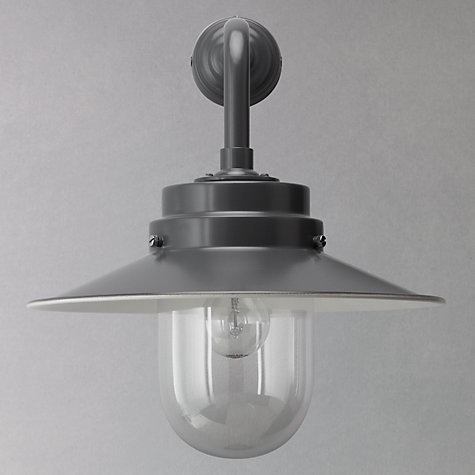
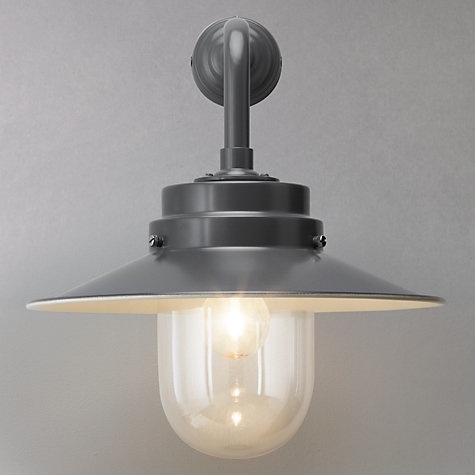
Tuesday, September 03, 2013
Jock Troup with a banjo-mandolin - and the Fishermen's Revival of the 1920s
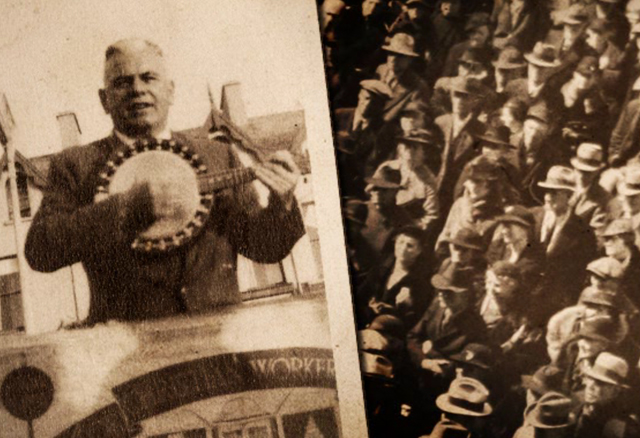
Pictured above is the famous Scottish evangelist Jock Troup (1896 - 1954). Also a singer, he is known to have played the banjo-mandolin occasionally as accompaniment; his brother Harry was a well known fiddle player in the north of Scotland. A summary of Jock's life is available here. He spent much time in Ulster and I know of elderly folk who remember him fondly. At the bottom of this post are two photos of him at Bangor Christian Workers Society at Pickie Pool along the seafront, where the platform still stands today, I think it now says 'Christ Died for the Ungodly'.
These images have been grabbed from an excellent 48 minute documentary DVD of Jock Troup's life, produced by Gary Wilkinson, which is available on his website here for £10.99 plus £1.50 postage. I bought three copies a while back to share with other folk - it is highly recommended. A trailer for the DVD can be seen below:
• Revival Man, the Jock Troup Story is a detailed biography of the man and his work. Available here and on Amazon here.
• For information on Scottish revivals generally, this book, Glory in the Glen, will be of interest.
• I contributed some digitised recordings of Jock singing to the website RareTunes.org back in August 2010. Click here to listen to the recordings.
• See previous blog post here.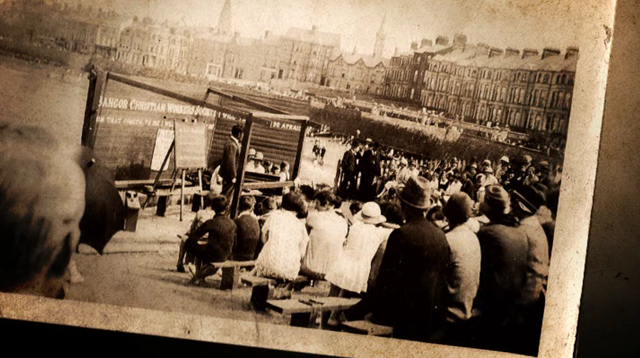

Friday, August 30, 2013
The Belfast Roof
Here is a feat of engineering which isn't talked about much. The Belfast Roof was an ingenious lattice system, developed around 1860. The trusses have a curved top, and could span huge distances with no need for any vertical supports like pillars inside. These meant that large open-plan buildings - like aircraft hangars - were much easier to build and work in. Aside from being structurally clever these were visually beautiful. Some pics below gathered up from various websites. It would be good to see these reintroduced to our local architecture.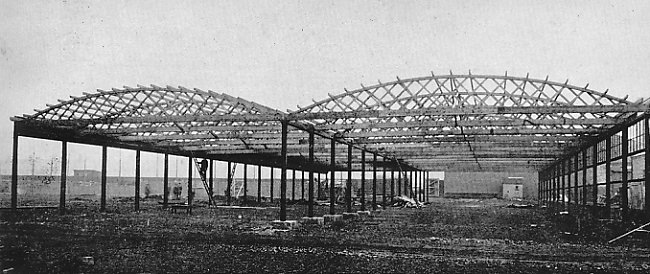

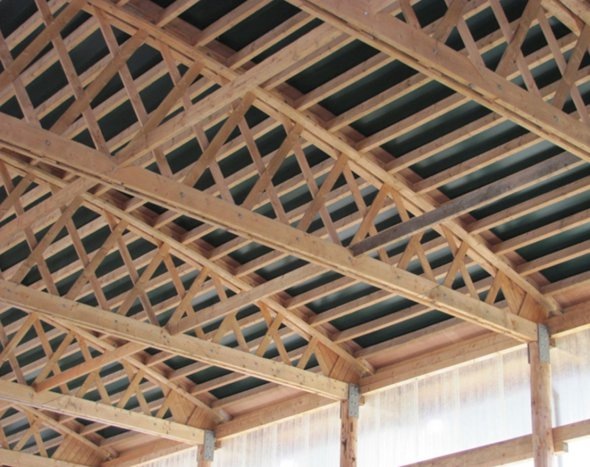
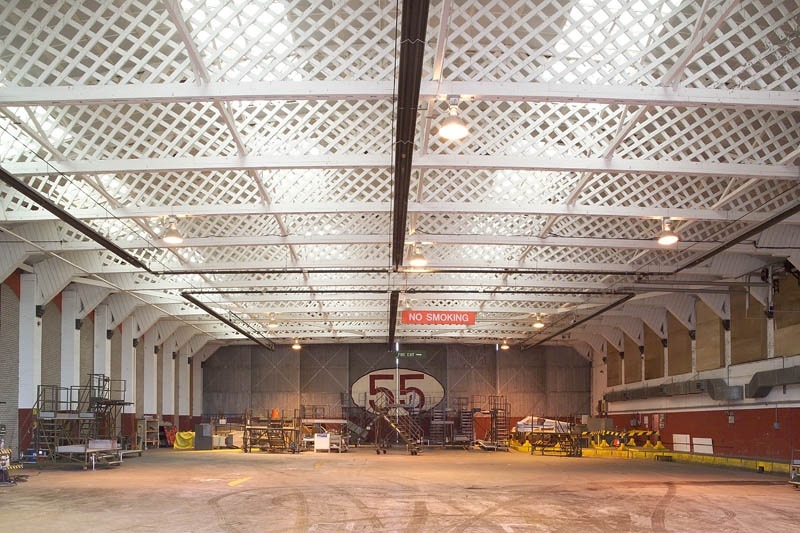
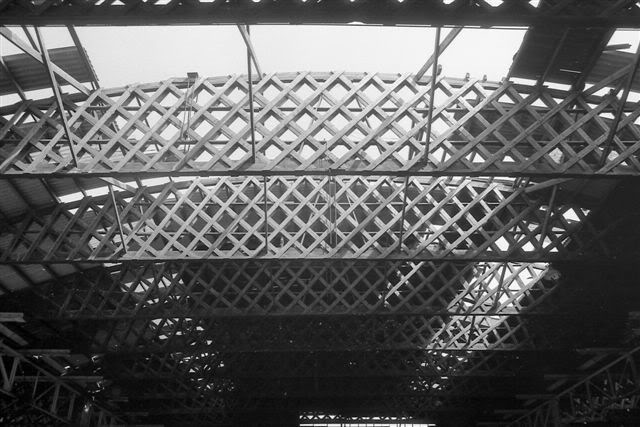
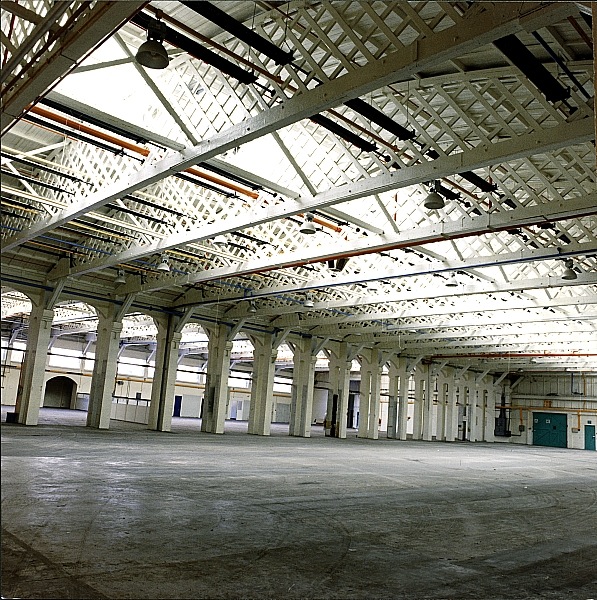
Saturday, August 24, 2013
'Handed Down - Country Fiddling and Dancing in East and Central Down' by Nigel Boullier

Earlier this year I had the privilege to work with Nigel Boullier to put together a truly groundbreaking publication of his collection of over 30 years of music, photographs, stories, biographies and dances from the part of County Down where we both live. The outcome is the 544 page Handed Down - Country Fiddling and Dancing in East and Central Down, published by the Ulster Historical Foundation.
It covers over 200 years of living tradition, of community, of a world which predates and defies the 'two tribes' stereotypical approach to Ulster life. Nigel writes with authority, through years of study and research but because he is a fiddle player himself and is writing about his own folk, people who have influenced him throughout his life - and in turn of the people who influenced them, all the way back to the late 1700s.
Handed Down is a colossal achievement on many levels, succeeding in being both intimate and yet scholarly. Whilst my task was mainly to make it all fit within our page quota I hope that the design approach helps to get the story across. It contains 500 fiddle tunes, 30 dances and biographies of 300 fiddle players. It begins with a detailed overview of the origins of music and dance in County Down and, to me, a refreshing summary of the politics which have done such damage to folk tradition - on the one hand through appropriation by Irish Nationalism, and on the other hand just outright neglect and abandonment by Ulster Unionism. Traditional music is seen in our generation as the preserve of 'one community'. Handed Down shows that it is in fact a common inheritance, one which our ancestors truly shared.
As Nigel knows, at times it was a tough design process, but the painstaking effort that we both applied to it over many months has really paid off. We got on like a house on fire and a Waltons Mountain badge lives to tell the tale (that's an in-joke for Nigel!). Further photographs to be posted soon.
Handed Down - Country Fiddling and Dancing in East and Central Down is available here priced at £24.99.
Thursday, August 22, 2013
Wednesday, August 21, 2013
Glenfield & Kennedy Ltd, Kilmarnock (photographed today at the Thompson Pump House, Belfast)
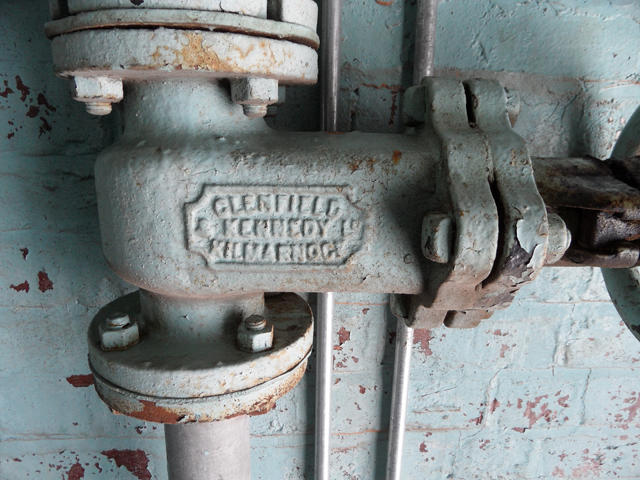
You can find out more about the company's history at FutureMuseum.co.uk (click here)
Thursday, August 15, 2013
Moody and Sankey in Dublin, 1874
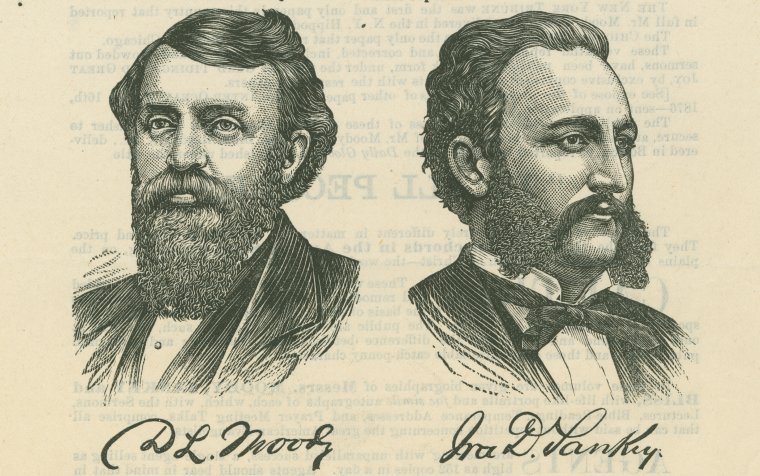
The two great American revivalists - DL Moody the preacher, and Ira D Sankey the song leader (who was of Scotch-Irish descent) - visited Britain in 1874. They arrived at Belfast on Sunday 6 September 1874 and preached to thousands of people until the following Sunday when they headed for Londonderry. From 24 October - 29 November they were in Dublin, again preaching to thousands every day. An account of their campaign in Dublin, printed in The Nation - said this:
'... Irish Catholics desire to see Protestants deeply imbued with religious feeling, rather than tinged with rationalism and infidelity; as long as the religious services of our Protestant neighbours are honestly directed to quickening religious thought in their own body, without offering aggressive or intentional insult to us, it is our duty to pay homage of our respect to their conscientious convictions; in a word do as we would be done by ...'
Remarking on this, a later author wrote '... it would surely be a bright and blessed day for our country, if this spirit of mutual respect and toleration were everywhere honestly acted out among us. Mr Moody never makes controversial reference to others. His success in attracting the favourable attention of our brethren of a different faith has been unexampled in the history of our city... men are not addressed as by their particular Church, but as sinners ...'
Wednesday, August 14, 2013
Sunday, August 11, 2013
Singing the Psalms in Prison
"... The dispute about Psalm-singing has broken out in an entirely unexpected quarter - an Irish prison. Some of the "Scotch-Irish" convicts have recently petitioned the chaplain not to use hymns in the prison service, but to use the Psalms, as the latter were inspired and the former were not. Perhaps if the criminals had shown the same degree of reverence for inspired writings before their incarceration, they would have saved themselves from much trouble and the country much expense ...'
- from the New York Times, 29 August 1869
Wednesday, August 07, 2013
Friday, August 02, 2013
Breakfast Ulster-Scots style
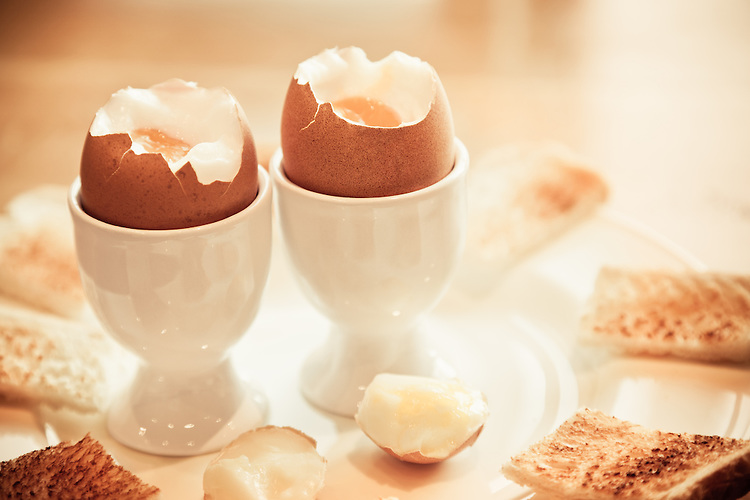
I was told this story many years ago. A big dour hefty man from Portavogie, John Thompson, married a thin timid wee woman called Maggie, probably some time in the 1950s. They moved into a cottage at the end of our road, at what was once a 'clachan' called Butterlump. On the day after the wedding, Maggie said to John:
"Whit way wud ye like yer egg this mornin John?"
Unimpressed, John said:
"Hmph. Alang wi anither yin".
Thursday, July 18, 2013
Animal cruelty
As I went up tae a wee hoose farm
A wee bark cam oot an dugged at me
I lifted my shouther over ma stick
An gien the wee dug such a lug on the lick
An made its water ee
(sent to me by Samuel, Carrowdore)
Monday, July 08, 2013
Joseph Braddell & Son, Belfast; manufacturers of breech loading shotguns, rifles & pistols. Established 1811
Saw this beautiful old label recently. Location of the shop? - next door to The Ulster Club - must have been a well-known venue in its day.